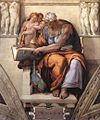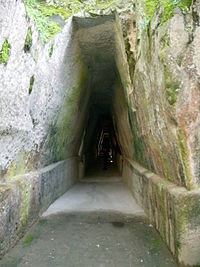- Cumaean Sibyl
-
The ageless Cumaean Sibyl was the priestess presiding over the Apollonian oracle at Cumae, a Greek colony located near Naples, Italy.
The word sibyl comes (via Latin) from the ancient Greek word sibylla, meaning prophetess. There were many Sibyls in different locations throughout the ancient world. The importance of the Cumaean Sibyl in the legends of early Rome as codified in Virgil's Aeneid VI, the Cumaean Sibyl became the most famous among the Romans, because she was near to Roma. The Erythraean Sibyl from modern day Turkey was famed among Greeks, as was the oldest Hellenic oracle, Sibyl of Dodona, possibly dating to the second millennium BCE according to Herodotus favored in the east.
The Cumaean Sibyl is one of the four sibyls painted by Raphael at Santa Maria della Pace (see gallery below.) She was also painted by Andrea del Castagno (Uffizi Gallery, illustration right), and in the Sistine Ceiling of Michelangelo her powerful presence overshadows every other Sibyl, even her younger and more beautiful sisters, such as the Delphic Sibyl.
There are various names for the Cumaean Sibyl besides the "Herophile" of Pausanias and Lactantius[1] or the Aeneid's "Deiphobe, daughter of Glaucus": "Amaltheia", "Demophile" or "Taraxandra" are all offered in various references.
Contents
Ancient Roman prophecies
The excellent story of the acquisition of the Sibylline Books by Lucius Tarquinius Superbus, the semi-legendary last king of the Roman Kingdom, or Tarquinius Priscus, is one of the famous mythic elements of Roman history.[2]
Centuries ago, concurrent with the 50th Olympiad not long before the expulsion of Rome's kings, an old woman "who was not a native of the country" (Dionysius) arrived incognita in Rome. She offered nine books of prophecies to King Tarquin; and as the king declined to purchase them, owing to the exorbitant price she demanded, she burned three and offered the remaining six to Tarquin at the same stiff price, which he again refused, whereupon she burned three more and repeated her offer. Tarquin then relented and purchased the last three at the full original price, whereupon she "disappeared from among men" (Dionysius).
The books were thereafter kept in the Temple of Jupiter on the Capitoline Hill, Rome, to be consulted only in emergencies. The temple burned down in the 80s BC, and the books with it, necessitating a re-collection of Sibylline prophecies from all parts of the empire (Tacitus 6.12). These were carefully sorted and those determined to be legitimate were saved in the rebuilt temple. The Emperor Augustus had them moved to the Temple of Apollo on the Palatine Hill, where they remained for most of the remaining Imperial Period.
The Books were burned in AD 405 by the General Flavius Stilicho, who was a Christian and regarded the books as Pagan and therefore evil. At the time of the Visigothic invasion five years later in AD 410, certain Pagan apologists bemoaned the loss of the books, claiming that the invasion of the city was evidence of the wrath of the Pagan gods over the destruction of the books.
The Cumaean Sibyl is featured in the works of, among others, Virgil (The Eclogues, The Æneid), Ovid (Metamorphoses) and Petronius (The Satyricon).
Stories recounted in Virgil's Æneid
The Cumaean Sibyl prophesied by “singing the fates” and writing on oak leaves. These would be arranged inside the entrance of her cave but, if the wind blew and scattered them, she would not help to reassemble the leaves to form the original prophecy again.
The Sibyl was a guide to the underworld (Hades), its entry being at the nearby crater of Avernus. Aeneas employed her services before his descent to the lower world to visit his dead father Anchises, but she warned him that it was no light undertaking:
- Trojan, Anchises' son, the descent of Avernus is easy.
- All night long, all day, the doors of Hades stand open.
- But to retrace the path, to come up to the sweet air of heaven,
- That is labour indeed. (Aeneid 6.126-129.)
Stories recounted in Ovid's Metamorphoses
Although she was a mortal, the Sibyl lived about a thousand years. This came about when Apollo offered to grant her a wish in exchange for her virginity; she took a handful of sand and asked to live for as many years as the grains of sand she held. Later, after she refused the god's love, he allowed her body to wither away because she failed to ask for eternal youth. Her body grew smaller with age and eventually was kept in a jar (ampulla). Eventually only her voice was left (Metamorphoses 14; compare the myth of Tithonus).[3]
Medieval Christianity
In the Middle Ages, both the Cumaean Sibyl and Virgil were considered prophets of the birth of Christ, because the fourth of Virgil's Eclogues appears to contain a Messianic prophecy by the Sibyl. In it, she foretells the coming of a savior – possibly a flattering reference to the poet's patron – whom Christians identified as Jesus.[4][5][6] and this was seized on by early Christians as such—one reason why Dante Alighieri later chose Virgil as his guide through the underworld in The Divine Comedy. Similarly, Michelangelo prominently featured the Cumaean Sibyl in the Sistine Chapel among the Old Testament prophets, as had earlier works such as the Tree of Jesse miniature in the Ingeberg Psalter (c. 1210).
Virgil may have been influenced by Hebrew texts, according to Tacitus, amongst others.
Constantine, the Christian emperor, in his first address to the assembly, interpreted the whole of The Eclogues as a reference to the coming of Christ, and quoted a long passage of the Sibylline Oracles (Book 8) containing an acrostic in which the initials from a series of verses read: Jesus Christ Son of God Saviour Cross.[7]
Later literature
The epigraph to T. S. Eliot's poem, "The Waste Land" (1922), is a quote from the Satyricon wherein Trimalchio states, "For I myself once saw with my own eyes the Sibyl hanging in her jar, and when the boys asked her, 'Sibyl, what do you want?' she answered 'I want to die.'".[4]
Robert Graves fashioned a poetic prophesy by the Sibyl to bind the story together in his work of historical fiction, I, Claudius (1934).
Geoffrey Hill's Poem "After Cumae" in For the Unfallen (1958) also refers to the Sibyl's 'mouthy cave'.
Mary Shelley claimed in the introduction to her novel, The Last Man, that in 1818 she discovered, in the Sibyl's cave near Naples, a collection of prophetic writings painted on leaves by the Cumaean Sibyl. She edited these writings into the current first-person narrative of a man living at the end of the 21st century, which proves to be the end of humanity.
Representations of the Sibyl of Cumae
-
By Andrea del Castagno at the Uffizi Gallery
-
By Michelangelo at the Sistine Chapel
-
By John Leech from The Comic History of Rome
The cave at Cumae
The famous cave known as the “Antro della Sibilla” was discovered by Amedeo Maiuri in 1932, the identification of which he based on the description by Virgil in the 6th book of the Aeneid, and also from the description by an anonymous author known as pseudo-Justin.( Verg. Aen. 6. 45–99; Ps-Justin, 37). The cave is a trapezoidal passage over 131 m long, running parallel to the side of the hill and cut out of the volcanic tuff stone. An innermost chamber, where the Sibyl was thought to have prophesied.
A nearby tunnel through the acropolis now known as the "Crypta Romana" (part of Agrippa and Octavian's defenses in the war against Sextus Pompey) was previously identified as the Grotto of the Sibyl.
The inner chamber was later used as an burial chamber during the 4th or 5th century AD (M. Napoli 1965, 105) by people living at the site.
Primary sources
- Virgil, Aeneis vi.268 ff
- Isidore, Etymologiae viii.8.5
- Servius, In Aeneida vi.72, 321
- Lactantius, Divinae institutiones i.6.10–11
- Solinus, Collectanea rerum memorabilium ii.16, 17, 18
See also
- The Golden Bough (mythology)
- Dido (Queen of Carthage)
Notes
- ^ Pausanias, 10.12.8; Lactantius, 1.6.10.
- ^ Dionysius of Halicarnassus, Roman Antiquities IV.62 (repeated by Aulus Gellius I.19); Varro, according to a remark in Lactantius I.6; Pliny's Natural History XIII.27; Of these sources, only Lactantius' Varro claims specifically that the old woman selling the books was the Cumaean Sibyl.
- ^ Article on the Cumean Sibyl – cf. section on The Sibyl and Apollo.
- ^ a b Eliot, T. S.; Rainey, Lawrence S., The Annotated Waste Land with Eliot's Contemporary Prose: Second Edition, Yale University Press, 2006 ISBN 0-300-11994-1. Cf. p.75
- ^ Pelikan, Jaroslav Jan, The Christian Tradition: A History of the Development of Doctrine, University of Chicago Press, 1989. ISBN 0-226-65371-4. Cf. p.64
- ^ Kiefer, Frederick, Writing on the Renaissance Stage: Written Words, Printed Pages, Metaphoric Books, University of Delaware Press, 1996. ISBN 0-87413-595-8. Cf. p.223.
- ^ Sibyls accessed December 31, 2007
Categories:- Ancient Roman religion
- Sibyls
- Roman mythology
- Characters in Book VI of the Aeneid
- Ancient Greek priestesses
Wikimedia Foundation. 2010.






